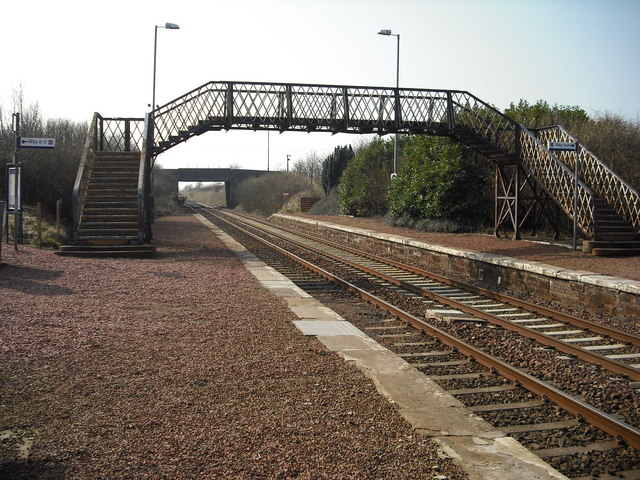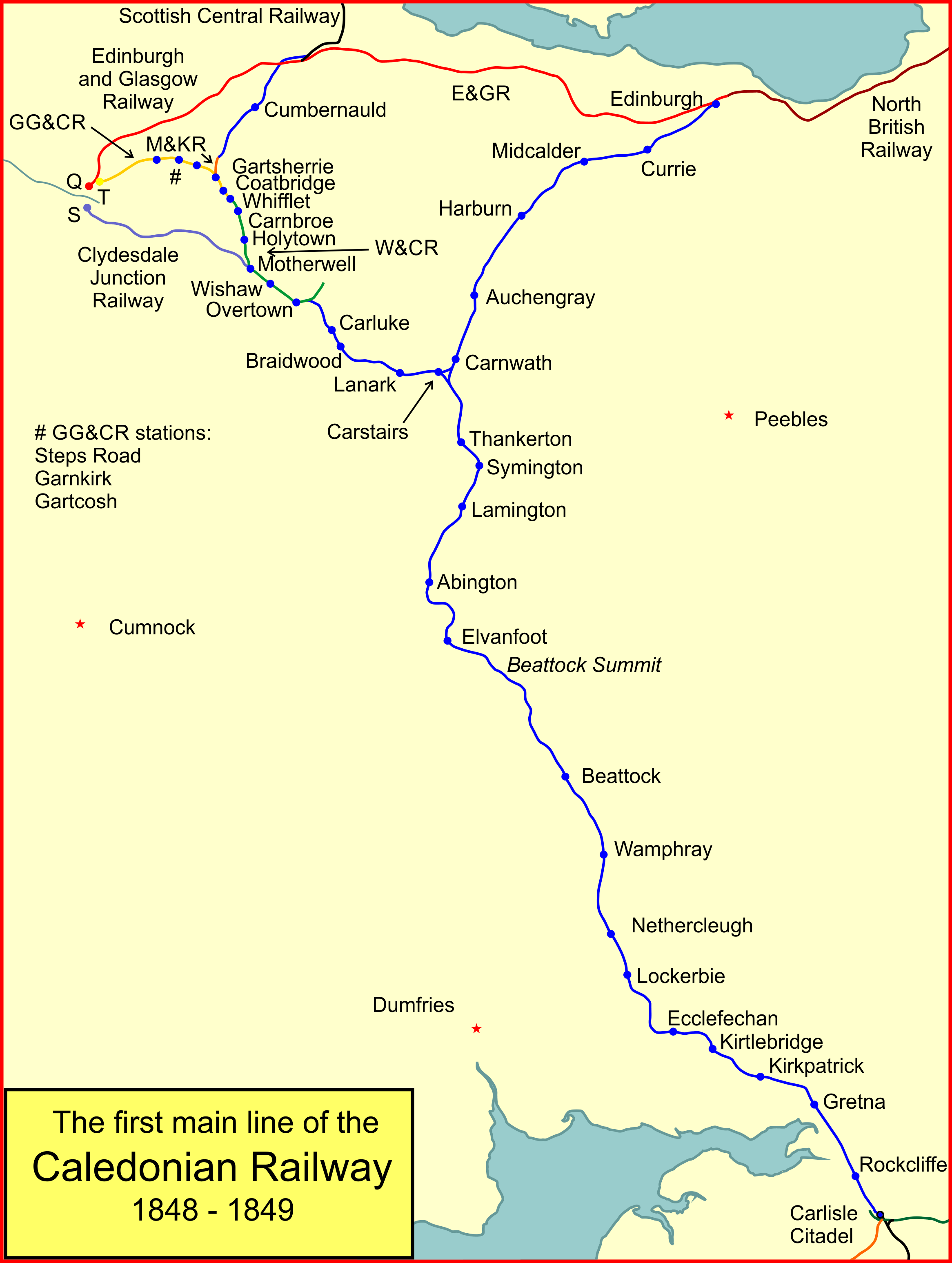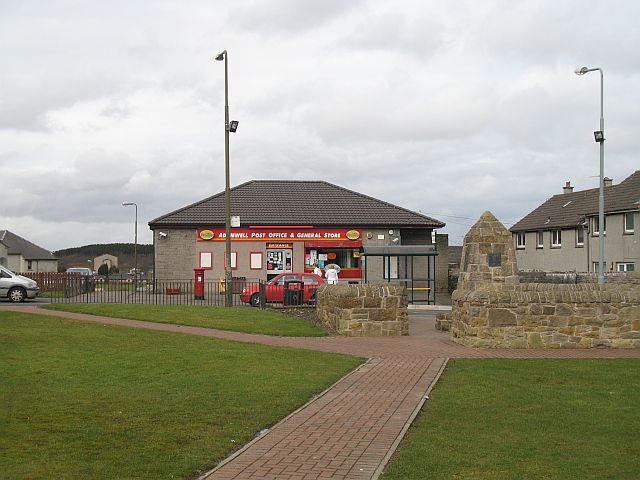|
Cleland And Midcalder Line
Cleland and Midcalder Line is a historic railway line in Scotland. Built by the Caledonian Railway and opened in 1869, it provides a link between Glasgow and Edinburgh through the mining communities of Lanarkshire and West Lothian. History The line was built by the Caledonian Railway to serve a variety of industrial locations, including collieries, iron mines and an oil works near Addiewell. It followed the route of an earlier private industrial line built to serve a number of mines in the area. The line became part of the London, Midland and Scottish Railway at the 1923 Grouping, then the Scottish Region of British Railways upon nationalisation in January 1948. None of the industries once served by the line still survive - the last of the collieries served by it (at Polkemmet) having closed down in 1986. Connections to other lines * Clydesdale Junction Railway at Uddingston Junction * Caledonian Railway Main Line (Carstairs to Greenhill Junction) at Mossend Junctions an ... [...More Info...] [...Related Items...] OR: [Wikipedia] [Google] [Baidu] |
Scotland
Scotland (, ) is a country that is part of the United Kingdom. Covering the northern third of the island of Great Britain, mainland Scotland has a border with England to the southeast and is otherwise surrounded by the Atlantic Ocean to the north and west, the North Sea to the northeast and east, and the Irish Sea to the south. It also contains more than 790 islands, principally in the archipelagos of the Hebrides and the Northern Isles. Most of the population, including the capital Edinburgh, is concentrated in the Central Belt—the plain between the Scottish Highlands and the Southern Uplands—in the Scottish Lowlands. Scotland is divided into 32 administrative subdivisions or local authorities, known as council areas. Glasgow City is the largest council area in terms of population, with Highland being the largest in terms of area. Limited self-governing power, covering matters such as education, social services and roads and transportation, is devolved from the Scott ... [...More Info...] [...Related Items...] OR: [Wikipedia] [Google] [Baidu] |
British Railways
British Railways (BR), which from 1965 traded as British Rail, was a state-owned company that operated most of the overground rail transport in Great Britain from 1948 to 1997. It was formed from the nationalisation of the Big Four British railway companies, and was privatised in stages between 1994 and 1997. Originally a trading brand of the Railway Executive of the British Transport Commission, it became an independent statutory corporation in January 1963, when it was formally renamed the British Railways Board. The period of nationalisation saw sweeping changes in the railway. A process of dieselisation and electrification took place, and by 1968 steam locomotives had been entirely replaced by diesel and electric traction, except for the Vale of Rheidol Railway (a narrow-gauge tourist line). Passengers replaced freight as the main source of business, and one-third of the network was closed by the Beeching cuts of the 1960s in an effort to reduce rail subsidies. On privatis ... [...More Info...] [...Related Items...] OR: [Wikipedia] [Google] [Baidu] |
Argyle Line
The Argyle Line is a suburban railway located in West Central Scotland. The line serves the commercial and shopping districts of Glasgow's central area, and connects towns from West Dunbartonshire to South Lanarkshire. Named for Glasgow's Argyle Street, the line uses the earlier cut-and-cover tunnel running beneath that thoroughfare. The term "Argyle Line" is commonly used to describe: * the extensive urban passenger train service that connects the towns and suburbs of North Clyde with Motherwell, Larkhall, and Lanark, to the southeast. Of the 48 stations, 4 are in West Dunbartonshire, 4 in East Dunbartonshire, 17 in Glasgow City, 10 in North Lanarkshire, and 13 in South Lanarkshire. * the central portion of railway infrastructure encompassing less than . History Prior to 1964 The Glasgow Central Railway (GCR) under central Glasgow opened in 1886, connecting the Lanarkshire and Dunbartonshire Railway at and Stobcross Railway at to the Lanarkshire and Ayrshire Railway near , ... [...More Info...] [...Related Items...] OR: [Wikipedia] [Google] [Baidu] |
Shotts Line
The Shotts Line is a suburban railway line linking and via in Scotland. It is one of the four rail links between the two cities. Between Glasgow Central and , the line is shared with the West Coast Main Line (WCML), before branching off towards , rejoining the Edinburgh branch of the WCML at Midcalder Junction. The line's electrification was completed in early April 2019. Glasgow to Edinburgh services The Shotts line does not carry the principal service between the cities, with the journey taking around half as long again as the fast and frequent Glasgow Queen Street-Edinburgh service via Falkirk, which is the premier commuter link between the two cities. History of route The majority of the route follows ex-Caledonian Railway metals, with the North British Railway at the Edinburgh end. * Glasgow Central Lines ( CR) * Polloc and Govan Railway between Eglinton Street Tunnels and (CR) * Clydesdale Junction Railway between and (CR) * Cleland and Midcalder Line between ... [...More Info...] [...Related Items...] OR: [Wikipedia] [Google] [Baidu] |
Wishaw And Coltness Railway
The Wishaw and Coltness Railway was an early Scottish mineral railway. It ran for approximately 11 miles from Chapel Colliery, at Newmains in North Lanarkshire connecting to the Monkland and Kirkintilloch Railway near Whifflet, giving a means of transport for minerals around Newmains to market in Glasgow and Edinburgh. Shortage of capital made construction slow, and the line was opened in stages from 1833, opening fully on 9 March 1844. It was built to the track gauge of , commonly used in Scotland for coal railways. It had several branches serving pits and ironworks. In 1849 it became part of the Caledonian Railway and sections of the original network form part of the modern West Coast Main Line railway. Formation of the railway In the early decades of the nineteenth century, the pace of industrialisation in central Scotland accelerated considerably, generating a huge demand for the raw materials of coal and iron ore. Transport of these heavy materials to market was a key issu ... [...More Info...] [...Related Items...] OR: [Wikipedia] [Google] [Baidu] |
Caledonian Railway Main Line
The Caledonian Railway main line in Scotland connected Glasgow and Edinburgh with Carlisle, via Carstairs and Beattock. It was opened in 1847 by the Caledonian Railway. The approach to Glasgow used railways already built, primarily for mineral traffic; these were later by-passed by a more direct route. Today, the route forms the northern section of the West Coast Main Line, and was electrified in the early 1970s. Opening From 1830 onwards considerable attention was given to the means by which Glasgow and Edinburgh might be connected to London, and as English railways began to develop into a network, the urgency of making a railway accelerated. The difficult terrain of the Southern Uplands and Cumberland made the selection of a route controversial. After much difficulty, the Caledonian Railway was authorised to build a line via Beattock; this was known as the ''Annandale Route''. On 10 September 1847 the line was opened between Carlisle and Beattock. The station at Carlisle ... [...More Info...] [...Related Items...] OR: [Wikipedia] [Google] [Baidu] |
Clydesdale Junction Railway
The Clydesdale Junction Railway company was formed to build a railway connecting Motherwell and Hamilton with Glasgow, in Scotland. Conceived for local journeys, it was used by the main line Caledonian Railway to get access to Glasgow, and was soon taken over by the larger company. The route formed an alternative main line to Glasgow for the Caledonian, and eventually was the dominant route to the city. Although the Company was taken over before completion of its line, its short route remains in heavy use today as part of the West Coast Main Line, carrying heavy inter-city and suburban traffic, and some freight. History Authorisation The Clydesdale Junction Railway was promoted to connect Hamilton and Motherwell with the southern side of Glasgow, by joining the eastern end of the Polloc and Govan Railway, and forming a short line from it to a Glasgow terminal. It obtained an authorising Act of Parliament on 31 July 1845, with capital of £330,000. At Motherwell it linked with ... [...More Info...] [...Related Items...] OR: [Wikipedia] [Google] [Baidu] |
Nationalisation
Nationalization (nationalisation in British English) is the process of transforming privately-owned assets into public assets by bringing them under the public ownership of a national government or state. Nationalization usually refers to private assets or to assets owned by lower levels of government (such as municipalities) being transferred to the state. Nationalization contrasts with privatization and with demutualization. When previously nationalized assets are privatized and subsequently returned to public ownership at a later stage, they are said to have undergone renationalization. Industries often subject to nationalization include the commanding heights of the economy – telecommunications, electric power, fossil fuels, railways, airlines, iron ore, media, postal services, banks, and water – though, in many jurisdictions, many such entities have no history of private ownership. Nationalization may occur with or without financial compensation to the former owners. ... [...More Info...] [...Related Items...] OR: [Wikipedia] [Google] [Baidu] |
1923 Grouping
The Railways Act 1921 (c. 55), also known as the Grouping Act, was an Act of Parliament enacted by the British government and intended to stem the losses being made by many of the country's 120 railway companies, by "grouping" them into four large companies dubbed the " Big Four". This was intended to move the railways away from internal competition, and retain some of the benefits which the country had derived from a government-controlled railway during and after the Great War of 1914–1918. The provisions of the Act took effect from the start of 1923. History The British railway system had been built up by more than a hundred railway companies, large and small, and often, particularly locally, in competition with each other. The parallel railways of the East Midlands and the rivalry between the South Eastern Railway and the London, Brighton and South Coast Railway at Hastings were two examples of such local competition. During the First World War the railways were under sta ... [...More Info...] [...Related Items...] OR: [Wikipedia] [Google] [Baidu] |
London Midland And Scottish Railway
The London, Midland and Scottish Railway (LMSIt has been argued that the initials LMSR should be used to be consistent with LNER, GWR and SR. The London, Midland and Scottish Railway's corporate image used LMS, and this is what is generally used in historical circles. The LMS occasionally also used the initials LM&SR. For consistency, this article uses the initials LMS.) was a British railway company. It was formed on 1 January 1923 under the Railways Act of 1921, which required the grouping of over 120 separate railways into four. The companies merged into the LMS included the London and North Western Railway, Midland Railway, the Lancashire and Yorkshire Railway (which had previously merged with the London and North Western Railway on 1 January 1922), several Scottish railway companies (including the Caledonian Railway), and numerous other, smaller ventures. Besides being the world's largest transport organisation, the company was also the largest commercial enterpri ... [...More Info...] [...Related Items...] OR: [Wikipedia] [Google] [Baidu] |
London, Midland And Scottish Railway
The London, Midland and Scottish Railway (LMSIt has been argued that the initials LMSR should be used to be consistent with LNER, GWR and SR. The London, Midland and Scottish Railway's corporate image used LMS, and this is what is generally used in historical circles. The LMS occasionally also used the initials LM&SR. For consistency, this article uses the initials LMS.) was a British railway company. It was formed on 1 January 1923 under the Railways Act of 1921, which required the grouping of over 120 separate railways into four. The companies merged into the LMS included the London and North Western Railway, Midland Railway, the Lancashire and Yorkshire Railway (which had previously merged with the London and North Western Railway on 1 January 1922), several Scottish railway companies (including the Caledonian Railway), and numerous other, smaller ventures. Besides being the world's largest transport organisation, the company was also the largest commercial enterprise ... [...More Info...] [...Related Items...] OR: [Wikipedia] [Google] [Baidu] |
Addiewell
Addiewell ( sco, Aidieswall, gd, Tobar Adaidh) is a former mining village in the Scottish council area of West Lothian. Historically it lies within the County of Midlothian. A new prison, HMP Addiewell, opened in 2008. There are two separate districts, Addiebrownhill and Loganlea. Addiewell is near Stoneyburn and West Calder. History In 1852 James Young left Manchester to return to live in Scotland. On return he bought the United States-registered patent for the production of paraffin oil by distillation of coal, known as the oil shale industry. Both the US and UK patents were subsequently upheld in both countries in a series of lawsuits, and other producers were obliged to pay him royalties. After his patents expired in 1864, in 1865 Young bought out his business partners at the Bathgate-based chemical works, and choose to build a larger factory at Addiewell, due to its location on the Breich river. After agreeing purchase of west from the village of West Calder, Young n ... [...More Info...] [...Related Items...] OR: [Wikipedia] [Google] [Baidu] |

.jpg)






